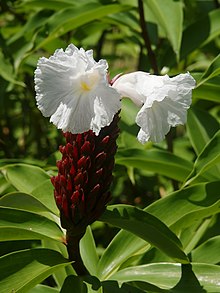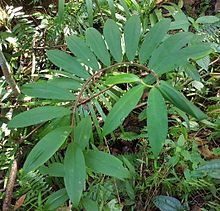Cheilocostus speciosus, or crêpe ginger, is a species of flowering plant in the family Costaceae. Some botanists have now revived the synonym Hellenia speciosa for this species.[3]
| Crêpe ginger | |
|---|---|

| |
| In Tortuguero, Costa Rica | |

| |
| In Bukidnon, Philippines | |
| Scientific classification | |
| Kingdom: | Plantae |
| Clade: | Tracheophytes |
| Clade: | Angiosperms |
| Clade: | Monocots |
| Clade: | Commelinids |
| Order: | Zingiberales |
| Family: | Costaceae |
| Genus: | Cheilocostus |
| Species: | C. speciosus
|
| Binomial name | |
| Cheilocostus speciosus | |
| Synonyms | |
many more | |
It is native to southeast Asia and surrounding regions, from India to China to Queensland, It is especially common on the Greater Sunda Islands in Indonesia. It is also reportedly naturalized in Puerto Rico, Mauritius, Réunion, Fiji, Hawaii, Costa Rica, Belize, Melanesia, Micronesia, and the West Indies. It is widely cultivated as an ornamental.[4]
Description
editCheilocostus speciosus and other members of the Costaceae differ from gingers by having only one row of spirally arranged leaves. The species reproduces vegetatively by rhizome, and birds disperse the seeds when they feed on the fruits.
This plant is cultivated in South Asia and Southeast Asia for its medicinal uses, and is cultivated elsewhere as an ornamental. In some areas Cheilocostus speciosus is introduced and has become an invasive species.
Habitat
editThe habitat where this species is found is roadside ditches and low-lying areas in tropical forests. Flowering starts after onset of the rainy season.
Ecology
editCaterpillars of the restricted demon (Notocrypta curvifascia) feed on crêpe ginger.[5]
Human relevance
editThe plant has many historical uses in Ayurveda, where the rhizome has been used to treat fever, rash, asthma, bronchitis, and intestinal worms.[6] It is mentioned in the Kama Sutra as an ingredient in a cosmetic to be used on the eyelashes to increase sexual attractiveness. It is used to treat kidney problems and other urinary problems in Mizo Traditional Medicine. It was used as a traditional medicine by Malays when evil spirits have possessed a body,[7] as well as for the treatment of high fever, smallpox and as a purgative.[8]
The crêpe ginger is also a source of diosgenin, a compound used for the commercial production of various steroids, such as progesterone.[9]
Several parts of the plant are eaten, including the flowers, leaves, shoots, and rhizomes.[10][11][12]
Gallery
edit-
Bud
-
Leaf from back side
-
Transformation from flower to seeds
-
Seeds
-
Inflorescence after flowers died
-
New leaf
-
In Basse Terre, Guadeloupe
-
New buds after winter
References
edit- ^ Poulsen, A.D.; van Caspel, P. (2020). "Cheilocostus speciosus". IUCN Red List of Threatened Species. 2020: e.T158548274A158548791. doi:10.2305/IUCN.UK.2020-2.RLTS.T158548274A158548791.en. Retrieved 20 November 2021.
- ^ "Cheilocostus speciosus (J.König) C.Specht". The Plant List. Retrieved 14 July 2013.
- ^ "Kew World Checklist of Selected Plant Families, Hellenia speciosa (retrieved 23 September 2020: also Plants of the World Online and IPNI)".
- ^ "Cheilocostus speciosus: info from PIER (PIER species info)". www.hear.org. Archived from the original on July 15, 2007.
- ^ Kunte, K. (2006). "Additions to the known larval host plants of Indian butterflies". J. Bombay Nat. Hist. Soc. 103 (1): 119–121.
- ^ "Crepe ginger (549)". Pacific Pests, Pathogens, Weeds & Pesticides.
- ^ "Cheilocostus speciosus (J. Koenig) C. Specht". National Parks Flora & Fauna web. Government of Singapore.
- ^ Samy, Joseph (2005). Herbs of Malaysia. Times Editions. p. 85. ISBN 9833001793.
- ^ Schmelzer, Gaby; Gurib-Fakim, Ameenah; Arroo, Randolph; Bosch, C.H.; de Ruijter, A.; Simmonds, Monique; Lemmens, R.H.M.J.; Oyen, L.P.A. (2008). Plant Resources of Tropical Africa 11(1) : Medicinal plants 1 (PDF). pp. 194–196. Retrieved 3 August 2024.
- ^ Clay, Horace F.; Hubbard, James C. (1977). The Hawai'i Garden. Honolulu: The University Press of Hawaii. pp. 206–207. ISBN 0-8248-0465-1.
- ^ Chan, Elisabeth (1998). Tropical plants of Malaysia & Singapore. Singapore: Periplus Editions. p. 10.
- ^ Abbasi, Arshad Mehmood; Bussmann, Rainer W. (2021). Ethnobiology of mountain communities in Asia (PDF). Cham, Switzerland: Springer International Publishing. p. 53.
External links
edit- Media related to Hellenia speciosa at Wikimedia Commons
- Horticultural Info
- FloriData Info Page
